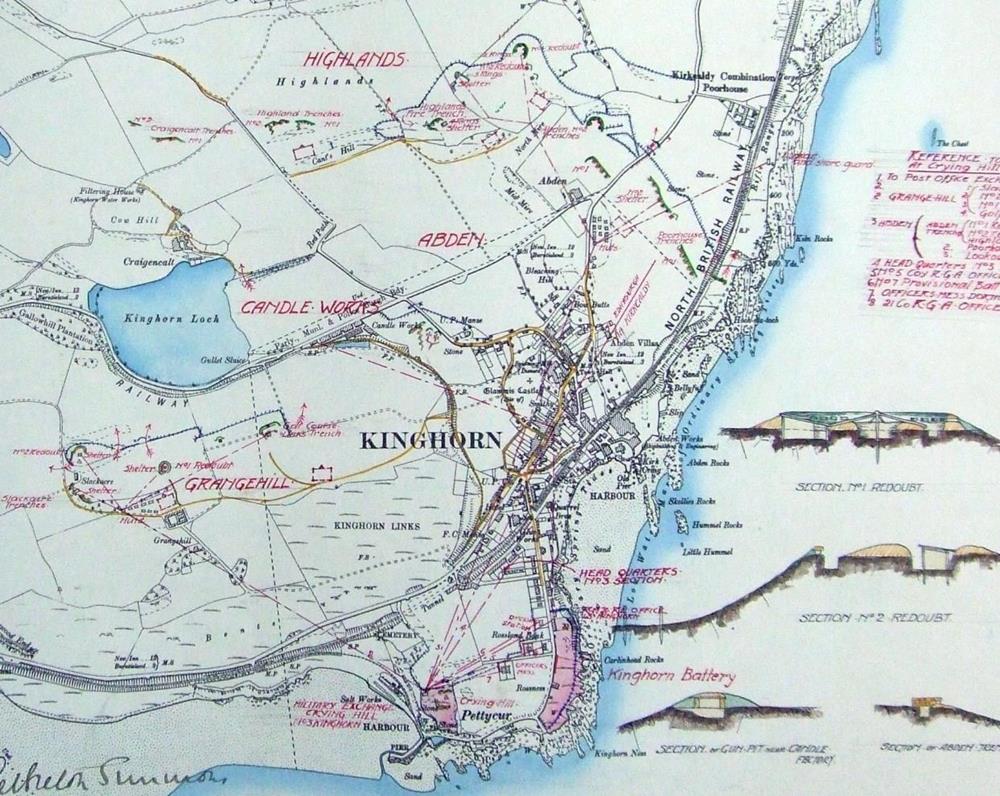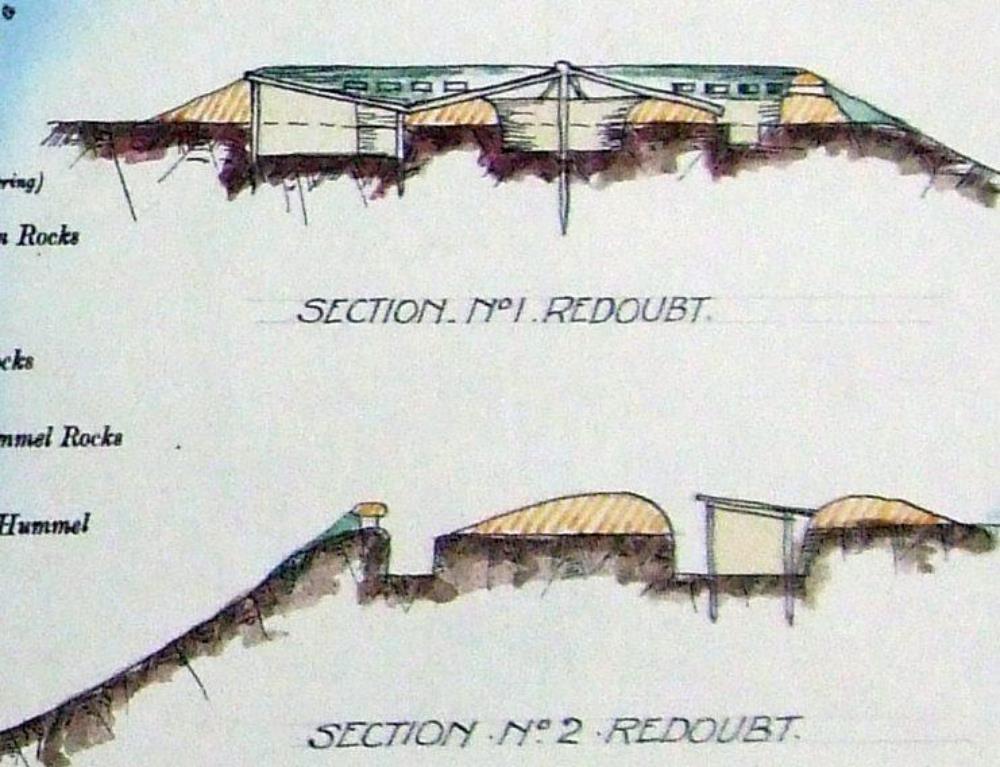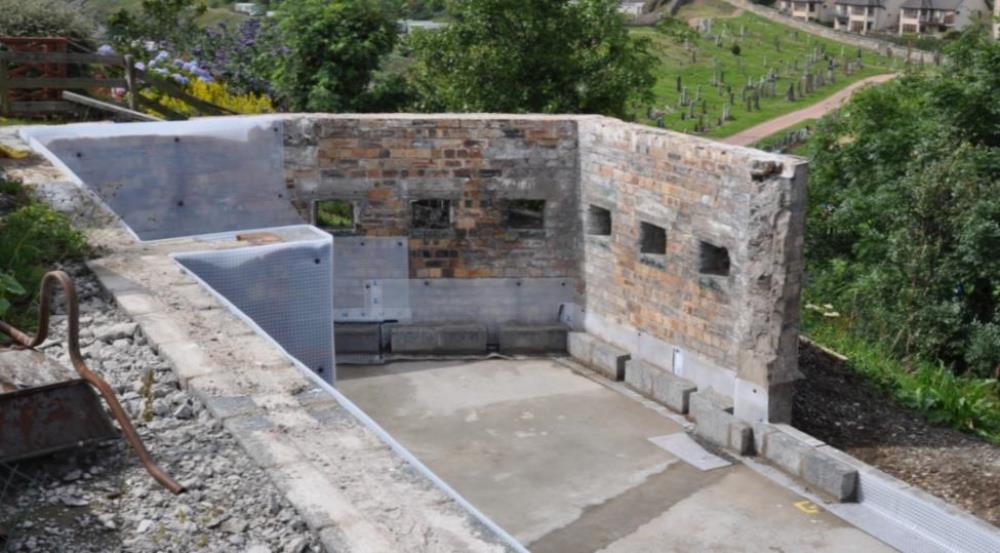Anti-invasion defences – Kinghorn and its hinterland
| < Methil-Balgonie | Δ Index | Inchkeith > |
The heaviest defences in Fife were built around and inland from Kinghorn. They were designed not only to protect the key coast defence battery there but also to provide a major obstacle to an enemy force moving west towards the Forth Bridge and Rosyth.
 Summary map of the defensive positions around Kinghorn, designed to protect the important coast artillery battery at Kinghorn, and to prevent an enemy force advancing along the coast towards Rosyth.
Summary map of the defensive positions around Kinghorn, designed to protect the important coast artillery battery at Kinghorn, and to prevent an enemy force advancing along the coast towards Rosyth.
The coastal approach from Kirkcaldy was blocked by a series of barbed wire entanglements in front of firing trenches and more substantial ‘redoubts’(temporary enclosed defensive positions) in the ‘Highlands’/‘Abden’ defence area. The approach to the town from the north was blocked by defences at ‘Candle Works’.
Finally, the direct north-west approach to the battery across open country was defended by entanglements, firing trenches, machine gun positions and a blockhouse on high ground at ‘Grangehill’. The ‘Abden’ and ‘Grangehill’ defences included accommodation huts for the defending infantrymen and their officers.
 Cross-sections of two of the ‘redoubts’ in the Kinghorn defences
Cross-sections of two of the ‘redoubts’ in the Kinghorn defences
A map of the Kinghorn and Pettycur batteries drawn in 1922 showed the location of three blockhouses, one of which had been built in 1914. One of these survived in good condition until 2016; by August of that year it had been unroofed and partly demolished, leaving two walls to be incorporated into a new building.
 The surviving blockhouse at Kinghorn/Pettycur, partially demolished and being incorporated into a modern building
The surviving blockhouse at Kinghorn/Pettycur, partially demolished and being incorporated into a modern building
In the General Mobilization Scheme the 7th (Territorial Force) Battalion of the Black Watch was detailed for coast defence and was allocated to the war stations of Kinghorn and Burntisland. ‘Preparatory Movement’ was ordered on the evening of 31 July 1914 and a ‘Special Service Section’ of three officers and 117 other ranks drawn from C Company (Kirkcaldy) and B Company (Lochgelly) was to be ready to occupy Kinghorn Fort. The Section arrived in Kinghorn on 2 August. Fortunately, they had conducted a test mobilization earlier in the year. The main body of the battalion arrived at its War Stations during the evening of 7 August.
The General Officer Commanding Scottish Coast Defences visited Kinghorn soon after the battalion’s arrival, and told the defending troops that an attack in force by the Germans might take place at any moment. It was assumed, he said, that any attack on the Forth could be dealt with by the Fleet and shore batteries, but it was thought possible that a landing might be effected somewhere on the east coast of Fife, with the object of taking Kinghorn Fort, the defences at Rosyth and the Forth Bridge from behind.
It was to foil such an attack that landward defences were built around the battery, in a semi-circle extending from the shore close to the poorhouse on the east, taking in the high ground to the north of the town, and ending on the Burntisland road west of the burgh boundary. A second, outer, line was prepared on the heights above the harbour of Pettycur, and a blockhouse was established on the Crying Hill, behind the Kinghorn battery. Several large houses in rear of the Fort were commandeered and put into a state of defence, to form a ‘keep’ in case the first and second lines were carried.
The construction of these works entailed much hard work, but they were completed in an intensive period of 36 hours of almost continuous digging. As 60% of the men of the 7th Battalion were connected with the mining industry, this achievement becomes comprehensible.
For the first three months after mobilisation the line was occupied in force under conditions closely approximating to those of active service. The part of the line between the coast and the Kirkcaldy road was low-lying and easily flooded in wet or snowy weather, giving a foretaste of the mud which the battalion first encountered on the Western Front in the spring of 1915. By degrees, the trenches were improved and various devices introduced to render them habitable and the battalion settled down to the ordinary routine of trench duties, the different companies being relieved at suitable intervals.
The garrison was reduced to detached sentry posts by the end of December 1914, but the supposed danger of invasion was not entirely removed, nor were the trenches completely evacuated until early 1915.
| < Methil-Balgonie | Δ Index | Inchkeith > |